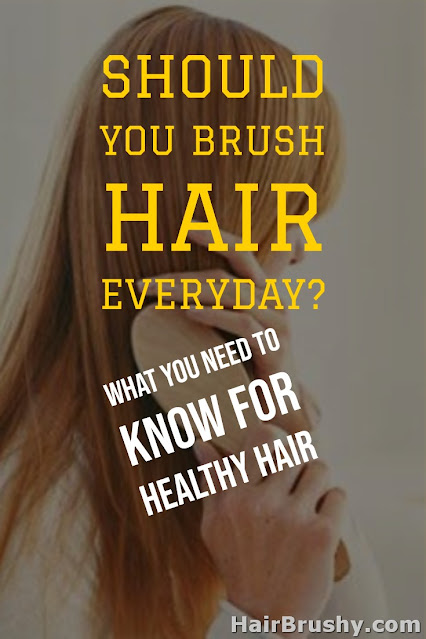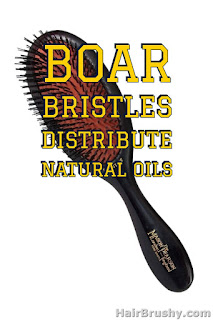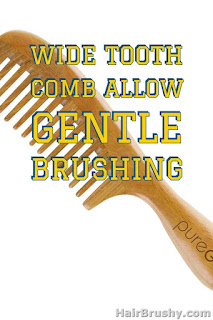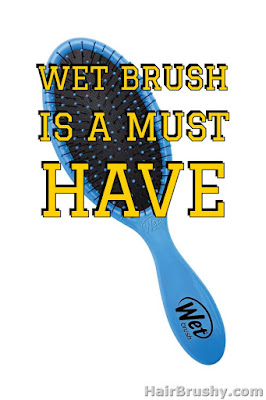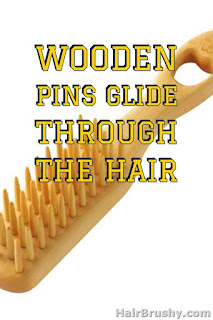Brushing your hair is dependent on your hair style. You do not have to brush for health reasons.In addition, your brushing technique also has a direct impact on your hair.
You should brush you hair everyday besides brushing your hair every day make you look wonderful. Brushing your hair everyday 100 brush strokes is not necessary for healthy hair. Other factors such as your overall health and nutrition have a bigger impact on your hair than brushing. Brushing hair can be as simple as running your fingers through.
6 Benefits Of Daily Brushing
- The benefit of daily brushing is it makes hair shine by flattening the cuticles which are the outer layers of the hair shaft. This makes the hair more shiny or reflective.
- Brushing can also add volume to flat or thin hair.
- Cleans the scalp by removing dead skin cells, old hair, and any other debris that can block skin pores and hair follicles.
- Stimulates the capillaries in the scalp thus increasing blood flow carrying oxygen and nutrients to hair follicles. Some say this encourages hair growth by strengthening hair roots.
- Stimulates sebaceous glands in your scalp that produce natural oils which serve as a natural conditioner. Brushing distributes your natural oil all along the hair shaft making the hair stronger, shinier, less dry, smoother and more resilient.
- removes excess natural oils from your scalp making your scalp less oily.
Top Hair Brushing Techniques And Tips
Top tips once recommended 100 brush strokes gave beautiful hair every night before bed. But remember that was long ago when shampoos and conditioners were not as popular. That amount of brushing is considered really excessive nowadays. Brushing remains an important part of grooming and moderation is the key for healthy hair. Over brushing can result in or exacerbate hair loss.
You might also be interested in reading my other article on “Are brushes bad for your hair“. I cover how incorrect brushing and the wrong brush can cause extensive hair and scalp damage.
Another high recommended article I wrote is “Is it bad to brush your hair a lot?” You may be causing more damage than good and it was surprising how many people may be over-brushing and not realizing it. And lastly I am sure you will want to read this one I wrote on “What happens if you don’t brush your hair“.
Use the right brush for your hair and hairstyle
- Use the right brush bristles – comes in different lengths and stiffness. Longer and stiffer bristles are best for thick and long hair as opposed to shorter softer bristles for shorter and thinner hair.
- Natural bristles – like boar bristles which are great for smoothing and polishing the cuticles for a shinny look.
- Wide tooth comb – great when combined with a leave in conditioner to undo knots and tangles.
- Paddle brush – covers more hair so it’s great if you have a lot of hair to brush. Covers approximately 25% more hair with every stroke. Great for long hair.
- Soft bristles – easy on the scalp so it’s good for thin, balding or short hair because there is less penetration. Great for folks who have sensitive scalps.
- Round brushes- great for styling and curling. Also comes in different barrel diameters for different curls.
- If you have questions or need help deciding which is best jut remember you can always ask your hairdresser.
Easy brushing does it
No need to vigorously attack your hair when brushing. Remember to be gentle and not to pull too hard. By brushing hard and vigorously you can damage the outside layer or cuticle of your hair. Bristles can rip and pull on your hair thus causing damage. Once you hair is damaged there is no repair. Your hair shaft is not a living thing so there is no way for it to grow back together. Once you have split ends for example the only real fix is to cut off the ends. If you have knots and tangles and you are struggling to get them out make sure to use the proper brush or comb with widely spaced; smooth teeth as not to rip your hair. And consider using a moisturizing conditioner or detangling spray to help with the tangles and knots.
If you have long hair and it’s in tangles and knots then brushing with strokes starting at the roots can often turn into a tugging war and thus end up breaking or pulling out your hair. A much gentler technique, is to start brushing with short strokes from the bottom, moving from tips to roots, untangling in sections until the brush easily passes the entire length of the hair.
Moderation is the key
Like most things in life moderation is the key. There is no need to over brush your hair. The idea that we should be brushing 100 strokes a day is a myth that comes from a time long ago when people didn’t wash their hair as often and did not have access to modern shampoos and conditioners. So back then the only option was a good brushing to remove dust and dirt. Fortunately we no longer live in those times. Most folks who use use modern shampoos and conditioners will only need to brush hair just enough to obtain their desired hairstyle.
Just like brushing moderation is the key when shampooing as well. Too much shampooing can dry out your hair and it’s unnecessary. Generally speaking there is no reason to over washing, brushing, handling, use hair-care products and over styling your hair. All this activity tends to wear on the cuticle. You should especially not do this if you have thin hair and your intentions are to grow your hair longer. This hair wears more quickly then thicker hair. The longer your hair the older it is and the older your hair the more washing, brushing and handling it has gone through. It eventually comes to a point where it has reached it limit and wears out.
Just think about all the excessive heat used to blow dry and style your hair. To grow hair down to the middle of your back it can take an average of of about 6 years. that is 6 years of using blow-dryers and flat irons on the ends of your hair. The lower the heat setting be better it’s going to be for your hair.
Brushing Wet Hair
Brushing Rule number one regarding wet hair. Never brush wet hair. Wet hair is at it’s weakest point while wet. It’s in an elastic state and by brushing you pull and create tension on your hair while brushing. The hair then stretches just like a rubber band and then pops or breaks when the tension is too much. At this state hair is very vulnerable to breakage.
What you want to do is to try not to handle wet hair. Or as little as possible. The ideal situation would be to wait till your hair is about 80% dry before styling. But if you must detangle or comb your hair while it’s wet then I suggest you use a wide tooth comb or a special detangle brush and use gentle brush strokes. Also use a conditioner or detangle spray. And start brushing or combing from the bottom up working your way to your hair line. Work in sections if you have a lot of hair.
Do not wrap your hair in a cotton towel. It’s too rough and will catch your hair and could cause your hair to break in some spots. The best technique is to let you hair dry naturally. You can use your hands to gently squeeze out as much water as possible. If you want you can wrap your hair in a softer fabric like a soft t-shirt for example but try not to wrap up until your hair is fairly dry, the drier the better and less likely damage will occur. Then when it’s about 80% dry you can style as normal.
Brushing Dry Hair
If you have curly hair you should not brush your hair when it’s bone dry. And the reason why is because the brushing is going to cause static and make your hair frizzy. Thicker curled hair is not as weak as thin hair so you can use a little moisture and untangle, style your hair using a brush or your fingers. Using damp fingers is a really good way to remove tangles. Another good technique to keep your curls is to use a hair pick. This way you wont’ flatten your curls. And of course the use of a good conditioner or anti-frizz products.
How to clean your brushes
It’s important to make sure your tools are clean for personal hygiene reasons. It’s good to remove hair and oils from your combs and brushes at least once a month, more depending on use and conditions. Some stylist recommend cleaning once a week. However there are some combs and brushes that you do not want to remove the natural oils from, so read the manufacture clean instructions. For example, a boar brush gets better with age due to the natural oils from your hair make the bristles more pliable and the oils gets distributed all along your hair shaft. So it’s advantageous to have natural oil in your boar brush. In addition, there are special combs that contain oils such as Coconut oil or Argan oil. Please read the cleaning instructions for these special combs since it’s advantageous to have oil infused into the plastic. For most brushes you can use a little warm water, shampoo and rinse. Repeat as needed. It’s common for most boar brushes to loose some bristles but when you have an entire plug gone or almost missing it’s time to replace your brush.
Brush recommendations
Brushing with boar bristles can help break up tangles and knots gently while distributing natural oils and promoting a sleeker appeal.
Different brushes are always needed for blow drying and styling. Great choices are a Denman brush for straighter hair, paddle brush for wrap drying, or a round brush for creating lots of volume, waves and curls.
Having a wide tooth comb in your arsenal is always a great idea. The spaces in a wide tooth comb allow gentle brushing without pulling or damaging the strands. Moreover, without causing breakage, these combs can help gently brush wet, conditioned hair in the shower.
A Wet Brush specifically designed to brush wet strands is a must have.
Japanese Tsuge wood brush is naturally oily so the wooden pins glide through the hair.
Sources:
- Journal of Dermatological Treatment The effect of brushing on hair loss in women by Alexander Kiderman
- Journal of Cosmetic Science. Hair breakage during combing. 2007. by Robbins C and Kamath Y
- Image courtesy of pin.it/f6wi53aqojybma

